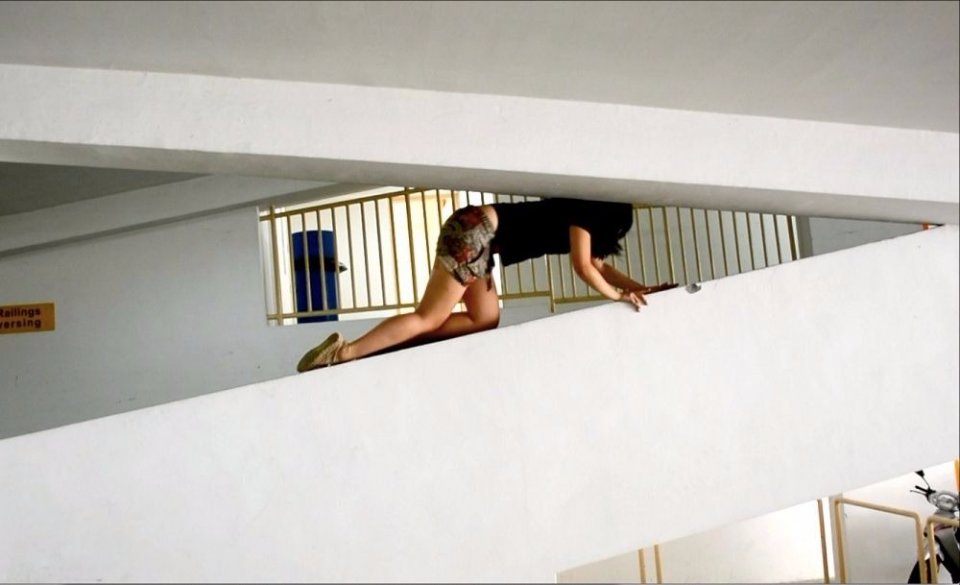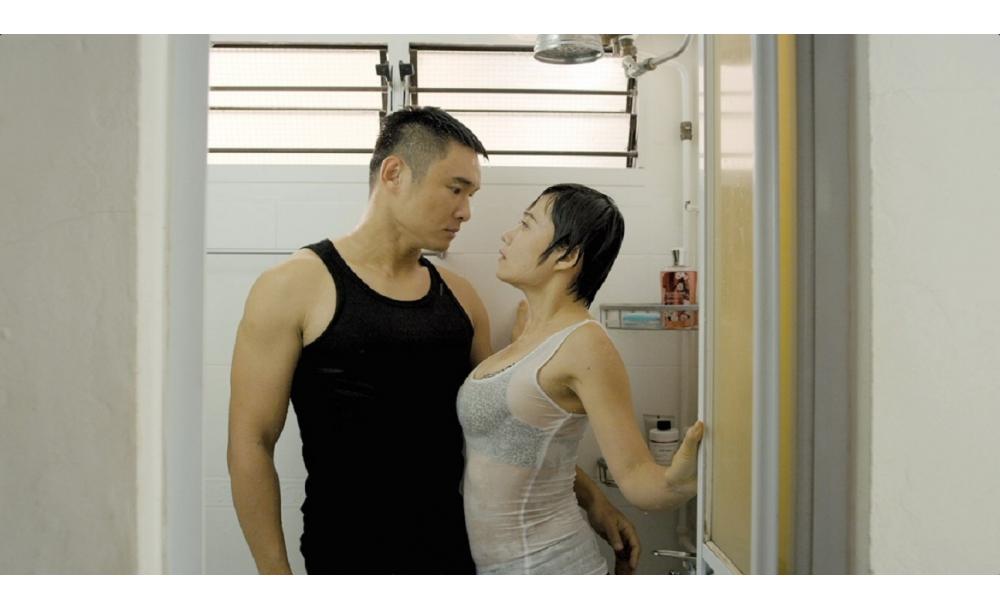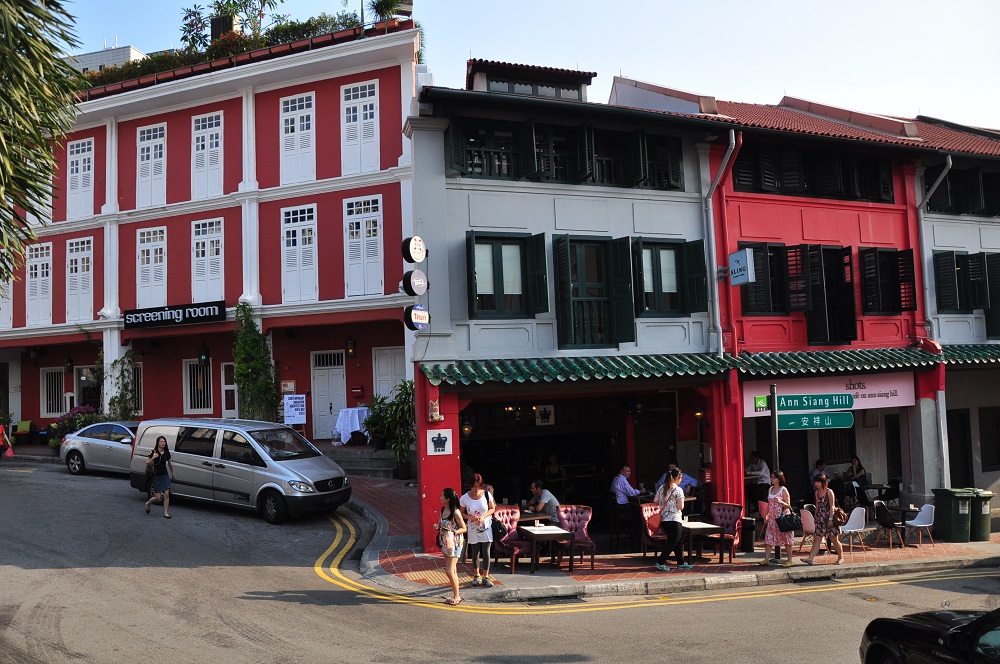When was the last time you stopped to think about how you move about in the city? Or questioned exactly who our thriving metropolis is designed for, all things (including a one-way traffic CBD that drives taxi uncles crazy) considered?
These are just some of the questions The Substation would like to pose to you, the undiscerning citizen, in its latest exhibition Discipline the City. Running in three acts from now through Nov 26, the exhibition features a permanent gallery of immersive installations, a rotating cast of artists, and a punk-in-residence program, which come together to comment on and challenge the hostility of design in Singapore.
Defensive architecture, for instance, plays a large role in the exhibition. In one room, neat rows of studs occupy a space on the floor of the gallery, forcing audiences to actively evaluate how they move about and around an anti-homeless city.
“The starting point is really about thinking who the city is for,” said Alan Oei, 41, Artistic Director of The Substation.
“If you think about Singapore, the city is increasingly becoming very exclusive; we intuitively know when we go to spaces whether we’re welcome or not. I think that this notion of the city becoming more and more disciplined, and how it in turn disciplines all of us, is really important for all of us to grapple with. Even auntie uncles, they know intuitively that the city is becoming this strange place where sometimes you’re not so welcome.”
In curating the space, Oei and co-curator Joshua Comaroff’s main focus was to give people a different experience of space, rather than “to just keep hitting them on the head with ‘Discipline the City’”. The result is an enlightening hodgepodge of multimedia and interactive installations, which range from a narrow alleyway in the corner of the gallery intended to fat-shame you, to a series of videos demonstrating how inhospitable the city can be.
As part of a larger artist space, a video by 24-year-old artist Avery Chen sees her climbing through barricades and carpark ramps as if manoeuvring a playground, to show how spaces in Singapore, without their original function, can be oppressive.

Down in the permanent gallery, a star feature is local artist Chen Sai Hua Kuan’s exhibit—a space that can only be described as an all-white cave, fully curved on all walls to reflect light and prevent even a hint of shadow.
It was inspired by a blank piece of white paper, and Chen’s determination to explore how he could extend it forever. The artist also explained that it was his inability to “adapt to the noisiness” of Singapore, after returning home from seven years in the UK, that pushed him to want to create a room of complete quiet and solitude.
“For me that’s about space and our experience of space; about your body coming back in some way,” said Oei in response. “When we walk down the city we almost forget about our bodies—until you get to the MRT and everyone’s squeezed together. So are cities designed for bodies?”
While the exhibition has been several months in the making, its opening comes at a politically relevant time. For the curators, the post-rally buzz surrounding Singapore becoming a smart nation, and particularly going cashless, only emphasizes the need to have this conversation, and have it now. Oei for one has some blunt opinions about it.
“There’s this very triumphalist narrative; people think that as long as you’ve got all the data, you’ve got very smart bureaucrats, smart designers, you can solve all the problems of the world; that you can design to death every single thing—and I think that’s exactly the problem for me,” he said. “When you over-design and you over-regulate things, what happens if you’re not part of who they design for?”
Design here isn’t just limited to architecture, or electronic conveniences. Oei added that pop-up initiatives that cater to a very specific audience are part of the problem.
“If there’s a wonderful pop-up for middle-class Chinese Singaporeans, and you’re not one of those people, what does the city mean to you?”
“Like if you’re a punk, would you ever go to Singapore Night Festival?” he jibed, in reference to the punk artist residencies that are part of Discipline the City. The punk community has always been viewed as an excluded subculture—hence the prominent inclusion of punk in this year’s theme and exhibition. “Just from an ideological view, I think the city should be for everyone, and that you shouldn’t over-design things; you should just allow organic life to occur.”
It’s a lot of shade to handle all in one exhibition, but perhaps very necessary in moving forward as a collective nation. To hear more from Oei, read on.
How did you decide on this year’s theme for the Substation?
What’s the traditional Singapore experience? It’s ERP gantries, your studs, your under-the-void-deck railings to stop kids from playing—when actually a void deck was supposed to be a communal space for people. It’s taken on this different, strange life, in the way of sanitizing spaces, keeping spaces clean and nice; like people should not be there.
I think we’ve all gotten used to it; we all know what defensive architecture is. We look at the studs in the pavement, chairs that don’t allow you to lie down and sleep. It’s crazy because Joshua even told me about these hedges that grow outwards so that migrant workers cannot sit on the curbs. It’s that level of invasiveness, but we just kind of get used to it, and after a while we just get desensitized. So the whole exhibition, when you walk through the space, is about hyper-realizing all of these things again; we really bring it to the extremities. We realize that actually the city takes a toll on you, and there are all these psychological barriers and inhospitable ways of thinking about the city.
Why now?
Because I think it’s of great importance for us in Singapore. Architecture in itself is becoming co-opted into providing the spectacle and the images for Singapore, rather than thinking about how architecture can design space for people to use in good ways. But we’re less interested in that right now than creating “starchitect” works—you know, very iconic Zaha Hadid works, or Le Corbusier; just creating these very iconic things that end up typically being the same images that always come up when you search Singapore on the Internet—Marina Bay Sands, the skyline. As cities become more and more like images that people identify with, where is the space for all of us to use and actually live in this city? So we want to ask: Is that an important question for people?
How else is the city hostile to its inhabitants?
Defensive architecture has been around for quite some time, but the other strand we keep talking about right now is placemaking, like converting a place to a vibrant cultural hub. Stuff like pop-ups and bazaars; it seems like the city has driven people away and is now trying to draw them back in.
Wouldn’t it be a good thing that it’s drawing people back in?
No, it’s horrible! Because you kicked people out in the first place. It’s gentrification. Even for instance here, Armenian Street, six, seven years ago it was a much more lively space—you had the National Library, you had MPH, worker dormitories, people who actually lived here, with coffeeshops and things like that. But with gentrification, rising rents; what do you have around here right now? Very expensive offices, and that’s why your space is empty—you have no real sense of life here anymore.
Then now they want to draw back a certain kind of people. But what is this certain kind of people? It’s a particular kind of model citizen, model consumer; and again that question—if you’re not one of these people, is there a space for you?
You mentioned PM Lee’s comment on smart cities. Are you in favor of becoming a smart nation?
I’m not. There are already a lot of articles with people asking who is this smart city for. How about old people who are more comfortable using cash? Exactly what does it do? There’s this seamless flow of transactions; but we’re human beings, we’re not data, we’re not statistics. We want to have a sense of who we are, and we want to be able to play in the city. When you reduce everything to this flow of goods and people, is that really good for us? I think that the smart city is one way of thinking of how we want our cities to evolve; there are other ways, and this exhibition is a starting point to think about what else we want from cities.
What is one message you want your audience to leave here with?
We’d like to get people to start thinking about space, and what kind of spaces they want in the city—whether it’s to play, to work, to live; and to participate in that conversation. I don’t think it should be only on the state to design and regulate spaces for us. I think we need to be part of the conversation.
Discipline the City runs from now to Sep 24, Oct 4-22, and Nov 1-26 at The Substation. More information here.





